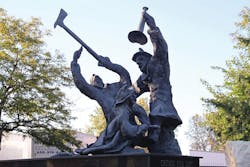100 Years Ago:
Dozens of Philadelphia Firefighters Trapped in Burning Debris
PHILADELPHIA, PA: DEC. 21, 1910 — Firemen rolled out to a reported fire at 1114 North Bodine St., a five-story leather factory. Heavy fire was found on the first floor upon arrival and a second alarm was transmitted immediately.
Despite the volume of fire, an aggressive interior fire attack was begun. The fire spread quickly through numerous vertical openings to the floors above and soon the fire was out of control. For almost three hours, the battle continued as firemen pressed their hoses closer and closer to the seat of the fire and worked from ladders trying to vent and expose the flames.
Without warning, a major collapse occurred, trapping 36 firemen in the flaming debris. Rescue efforts began immediately as wave after wave of firemen and policemen began digging out the imprisoned men. A number of men were rescued from the collapse area and rushed to hospitals. The heroic rescue operations continued for two hours until a second collapse occurred, bringing the number trapped to 51. The rescue effort was renewed.
The last live fireman, William Glazier of Engine 6, was freed from underneath a heavy beam and some machinery after a 12-hour rescue operation. Despite freezing temperatures, firemen cut, lifted and moved the charred remains of the factory until the last of their brothers was recovered. In all, 13 firemen and one police officer were killed and more than 50 men were injured, many seriously.
Explosion and Collapse Deadly to Chicago Firefighters
CHICAGO, IL: DEC. 22, 1910 — At 4:09 A.M., an alarm was struck for a fire in the Nelson Morris & Co. meatpacking plant in the Union Stockyards. On arrival, a night watchman reported a fire in the basement of the six-story cold storage building. Thirty minutes later, four alarms had been transmitted as firemen faced an advanced fire situation with numerous difficulties making matters worse.
The interior walls of the structure were wooden and soaked with years of animal fat and grease, and tons of stored meat was covered with saltpeter, one of the main ingredients in gunpowder. Outside, things were also taking a turn for the worse when firemen discovered nearby fire hydrants had been shut off to prevent freezing. By the time a water source was secured, the building was fully involved. A number of physical obstacles also hampered the firemen's efforts as nearby railway cars, brick walls and other structures closely surrounded the blazing building.
Chief James Horan was directing a group of firemen who had stretched lines over a railcar and were operating from a loading dock when an explosion rocked the building, toppling a six-story wall across the loading dock and killing the chief, Assistant Chief William Burroughs, three captains, four lieutenants and 12 firemen. The explosion and collapse made the difficult operation worse as firemen, with their command structure in shambles, now had to continue battling the blaze as they initiated a rescue operation.
First Assistant Chief Charles Seyferlich assumed command and directed operations. Additional alarms and special calls were sent in bringing the total number of units to 50 engine companies and seven hook-and-ladders at the scene. The fire and rescue operation continued for more than 24 hours until the fire was finally declared under control at 6:37 A.M. on Dec. 23.
Only the 9/11 World Trade Center terrorist attacks and the 1947 Texas City, TX, seaport disaster claimed more firefighter lives than these two tragic fires in December 1910.
PAUL HASHAGEN, a Firehouse® contributing editor, is a retired FDNY firefighter who was assigned to Rescue 1 in Manhattan. He is also an ex-chief of the Freeport, NY, Fire Department. Hashagen is the author of FDNY: The Bravest, An Illustrated History 1865–2002, the official history of the New York City Fire Department, and other fire service books. His latest novel, Fire of God, is available at dmcfirebooks.com.
Paul Hashagen
PAUL HASHAGEN, a Firehouse® contributing editor, is a retired FDNY firefighter who was assigned to Rescue 1 in Manhattan. He is also an ex-chief of the Freeport, NY, Fire Department. Hashagen is the author of FDNY: The Bravest, An Illustrated History 1865-2002, the official history of the New York City Fire Department, and other fire service books.
Connect with Paul
Website: paulhashagen.com
Facebook: Paul Hashagen-author






